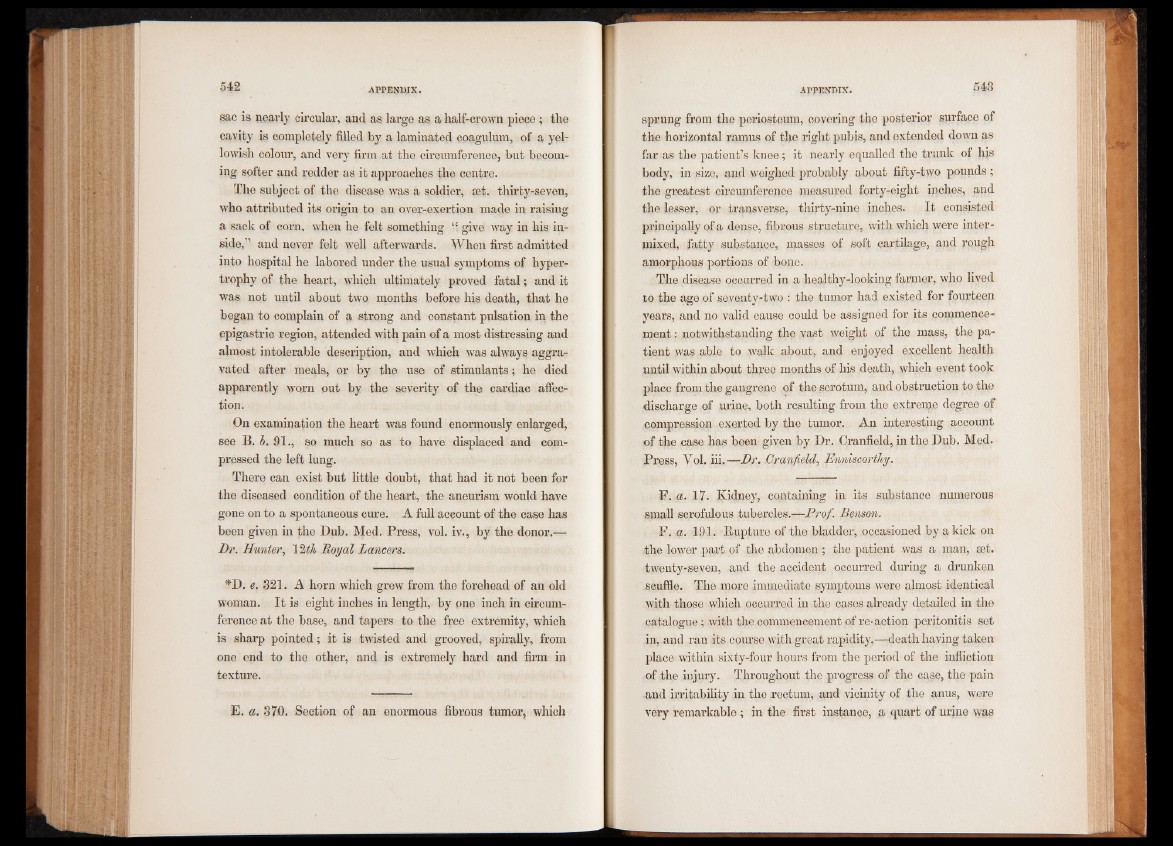
sac is nearly circular, and as large as a half-crown piece ; the
cavity is completely filled by a laminated cpagulum, of a yellowish
colour, and very firm at the circumference, but becoming
softer and redder as it approaches the centre.
The subject of the disease was a soldier, set. thirty-seven,
who attributed its origin to an over-exertion made in raising
a sack of corn, when he felt something “ give way in his inside,”
and never felt well afterwards. When first admitted
into hospital he labored under the usual symptoms of hypertrophy
of the heart, which ultimately proved fatal; and it
was not until about two. months before his death, that he
began to complain of a strong and constant pulsation in the
epigastric region, attended with pain of a most distressing and
almost intolerable description, and which was always aggravated
after meals, or by the use of stimulants; he died
apparently worn out by the severity of the cardiac affection.
On examination the heart was found enormously enlarged,
see B. b. 91., so much so as to have displaced and compressed
the left lung.
There can exist but little doubt, that had it not been for
the diseased condition of the heart, the aneurism would have
gone on to a spontaneous cure. A full account of the case has
been given in the Dub. Med. Press, vol. iv., by the donor.—
Dr. Hunter, \%th Royal Lancers.
*D. e. 321. A horn which grew from the forehead of an old
woman. It is eight inches in length, by one inch in circumference
at the base, and tapers to the free extremity, which
is sharp pointed; it is twisted and grooved, spirally, from
one end to the other, and is extremely hard and firm in
texture.
E. a. 370. Section of an enormous fibrous tumor, which
sprung from the periosteum, covering the posterior surface of
the horizontal ramus of the right pubis, and extended down as
far as the patient’s knee; it nearly equalled the trunk of his
body, in size, and weighed probably about fifty-two pounds;
the greatest circumference measured forty-eight inches, and
the lesser, or transverse, thirty-nine inches. It consisted
principally of a dense, fibrous structure, with which were intermixed,
fatty substance, masses of soft cartilage, and rough
amorphous portions of bone.
The disease occurred in a healthy-looking farmer, who lived
to the age of seventy-two : the tumor had existed for fourteen
years, and no valid cause could be assigned for its commencement
: notwithstanding the vast weight of the mass, the patient
was able to walk about, and enjoyed excellent health
until within about three months of his death, which event took
place from the gangrene of the scrotum, and obstruction to the
discharge of urine, both resulting from the extreme degree of
compression exerted by the tumor. An interesting account
of the case has been given by Dr. Cranfield, in the Dub. Med.
Press, Yol. iii.—D r.,Cranfield, Enniscorthy.
F. a. 17. Kidney, containing in its substance numerous
small scrofulous tubercles.—Prof. Benson.
F. a. 191. Eupture of the bladder, occasioned by a kick on
the lower part of the abdomen ; the patient was a man, set.
twenty-seven, and the accident occurred during a drunken
scuffle. The more immediate symptoms were almost identical
with those which occurred in the cases already detailed in the
catalogue.; with the commencement of re-action peritonitis set
in, and ran its course with great rapidity,—death having taken
place within sixty-four hours from the period of the infliction
of the injury. Throughout the progress of the case, the pain
and irritability in the rectum, and vicinity of the anus, were
very remarkable ; in the first instance, a quart of urine was